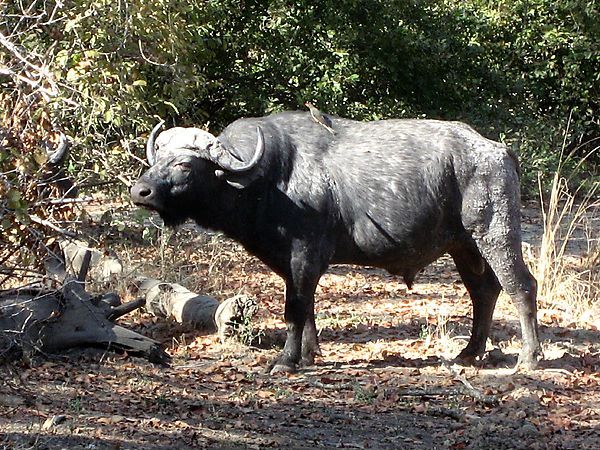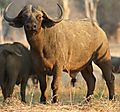Buffalo
Parent page
On this page
Introduction to the Buffalo (Syncerus caffer)
Description and Characteristics
The African Buffalo is Africa's only wild cow and is the same species domestic cattle. They are referred to as Buffalo, Cape buffalo, Forest buffalo, and Savannah buffalo.
They are strong and imposing, being of stocky build and cattle like. Their colouring is blackish grey or dark brown and both male and female have upturned horns, meeting at a central "boss" on their forehead, which is bigger in males
The forest buffalo is smaller and reddish brown in colour, their horns sweep up in a more backwards directions.
Calves of both types have red coats.
Buffalo live in herds of up to 1,000 individuals, mainly calves and females, the older males usually live away from the large herds. Large herds are usually fairly relaxed and generally do not attack, but when threatened by their main predator, a pride of Lions, the strong protective bond kicks in and the females in the herd will group together to defend another under attack from a predator. In large numbers they are capable of easily driving away a pride of lions. The older males that live away from large herds, either alone or in small groups are much more likely to charge.
Feeding/drinking Habits
Buffaloes are grazers and their diet consists of a variety of grasses, including the coarser grasses that other wildlife leave behind. During times of drought they will also eat the leaves of shrubs and trees. The best time to view them is early morning or at dusk when they are out grazing, during the heat of the day they tend to seek cover in shade or forest areas. Buffaloes need to drink at least once a day so they are never far from a water source.
Habitat
Buffaloes are widespread across Eastern and Southern Africa. They are usually found in large herds on open grasslands, savannah, swamps, floodplains woodland, and forest edges. As they need to drink at least once a day they are usually no more than 15kms away from a water source.
Size and Lifespan
At shoulder height then can range from 1 to 1.7 meters with its head-and-body length ranging from 1.7 to 3.4 m. Savannah type males can weigh anything from 500 to 910 kg , females and slightly smaller and weigh less. The Forest Buffalo is much smaller and weighs in at 250 to 455 kg. A buffaloes lifespan is between 15-25 years.
Reproduction
Females first calve at 5 years old. The gestation period is about 11½ months and they give birth to a single calf mainly during the raining seasons. Calves are generally weaned at approximately 10 months old. Males leave their mothers when they are two years old and join the bachelor groups. The young buffalo's horn boss is fully only upon reaching the age of 5–6 years
Predators and Threats
Being a member of the BIG 5, a name which comes from the days of colonial hunting, they used to under great threat as their were a prize trophy kill. However in more recent times, their numbers have been built up and they are widespread and they current status is not under threat.
Lions are their main predator. Outside national park boundaries, buffaloes often come into conflict with humans, they break fences, raid cultivated crops and may spread bovine diseases to livestock.



















